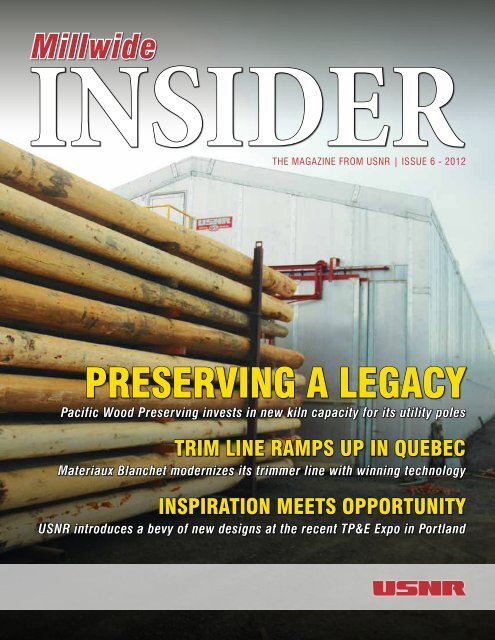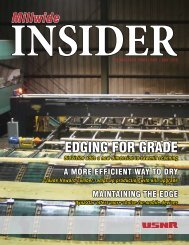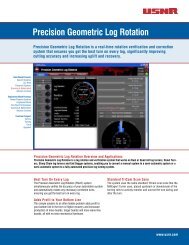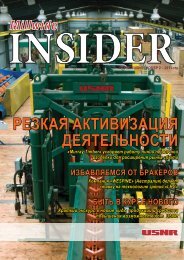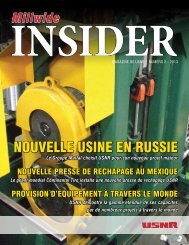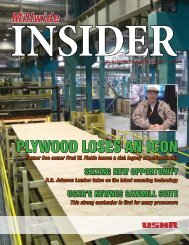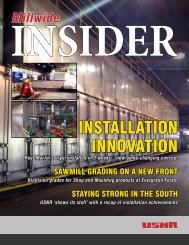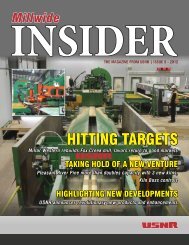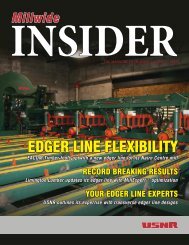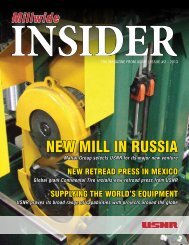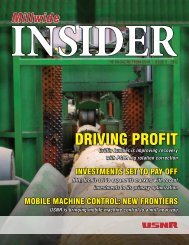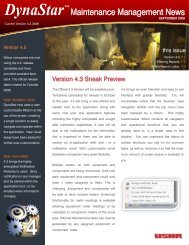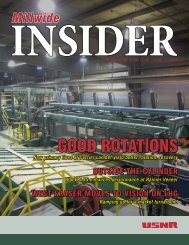Create successful ePaper yourself
Turn your PDF publications into a flip-book with our unique Google optimized e-Paper software.
MillwideINSIDERiSSUE 6 - <strong>2012</strong>SubscriptionsTel.: 250.833.3028subscriptions@usnr.comEditor<strong>Co</strong>lleen Schonheitercolleen.schonheiter@usnr.comCONTRIBUTING EDITORSonia Perrinesonia.perrine@usnr.comInspiration meets opportunityInspiration can come in many forms and from many different sources.Most commonly it is the result of customer and vendor putting their headstogether to solve the customer’s biggest challenge. And once in awhile itcomes via an ‘aha’ moment when inspiration meets opportunity. You canread about the results of some of these ‘aha’ moments in this issue.USNR Parts & Service7/24 Service: 800.BUY.USNRTel.: 360.225.8267Fax: 360.225.7146Mon. - Fri. 5:00 am - 5:00 pm PTwww.usnr.comUSNR LocationsA new pole kiln is the latest investment by Pacific WoodPreservers of Oregon, that is improving the throughput forthe operation, and helping to maintain the legacy of companyfounder, Dick Jackson.When Materiaux Blanchet, a Quebec lumber producer, decidedit was time to update its technology it chose a winningcombination of solutions provided by a vendor it has alwaystrusted to support its success.A complement to its lumber operation, Malheur Lumber bags itsplaner shavings for animal bedding. When the company decidedto expand this part of its business it chose USNR to design amachine that would meet its specifications.Parksville, BC250.954.1566Plessisville, QC819.362.8768Salmon Arm, BC250.832.7116Woodland, WAHeadquarters360.225.8267Eugene, OR541.485.7127Jacksonville, FL904.354.2301Painesville, OH440.352.9381USNR was recently honored to receive the <strong>2012</strong> Innovator ofthe Year award from EWTA/APA, installing and commissioningthe most productive jet veneer dryer in the SYP industry under avastly expedited schedule of only 3 weeks.For those of you who attended the recent Timber Processing andEnergy Expo, you couldn’t have missed USNR’s large displayfeaturing new, and some would even say, radical innovations.This issue offers a pictorial review, as well as a summary of thetwo technology sessions USNR took part in.© <strong>2012</strong>, U.S. Natural Resources, Inc.All rights reserved.POSTMASTER: Send address changes to1981 Schurman Way, Woodland, WA 98674.Canada Post: Return Undeliverable CanadianAddresses to: USNR c/o <strong>Co</strong>lleen Schonheiter,3550 - 45th Street Southeast,Salmon Arm, BC V1E 4N2USNR is pleased to continue to invest to offer you the best productsavailable on the global market.Sincerely,<strong>Co</strong>lleen SchonheiterEditor
Poles exit the dry end of the kiln once the drying cycle is complete.New kilnThe new kiln USNR designed is 35’ wide x 165’long, with double tracks to accommodate a largequantity of poles in one charge. It is constructedwith a steel frame and pre-fabricated aluminumpanels. One unusual aspect of this kiln is theaddition of a temporary wall that can be closedacross the middle of the kiln. This creates twosealed drying chambers, allowing the plant theflexibility of two separate charges at one time.Though this is not common, USNR has provided thisfeature previously at another installation.The new kiln has the capacity to dry 16,000cubic feet (of poles) per charge, and a kiln load ofpoles will dry in 4.5 days – down from 8 days withthe old drying unit. Dan Winkle, plant manager,commented, “We are able to dry 3.5 times theamount in half the time.”The kiln is fueled by a 300hp natural gasboiler producing steam heat. The steam producescondensate that is collected in an in-groundA pole is peeled prior to drying.condensate tank and then pumped back into theboiler in a closed-loop process.PWP dries their poles prior to treating, becausewhen the poles are green the preservative will notproperly penetrate the wood. Drying Douglas firlumber is significantly different from drying poles.Typically Douglas fir stud or dimension lumberdries in the range of 24 to 48 hours at a maximumtemperature of 200F degrees. In the case of poles,only the outer sap of the pole is dried – typically2-3 inches deep, at a maximum temperature of180F degrees. The pole’s sap is treated after thepoles are dried.<strong>Co</strong>ntrolling the processTwo other features of this new kiln are Kiln Bosscontrols and a moisture sensing system from SCSForest Products. The Kiln Boss system provides expertcontrol of all the drying variables. The Kiln Bosssystem is configured to control 8 heat zones with theheat source, venting and fans, and works in tandemwith the SCS in-kiln moisture sensing system. TheSCS system has 8 measuring points; the moisture“We are able to dry 3.5 times the amountin half the time.”readings are fed to the Kiln Boss system to controlthe drying schedule and shut-down the kiln at theend of the cycle. A Kiln Boss system equipped withmoisture sensing input allows the plant to use timeormoisture-based scheduling. The Kiln Boss systemmonitors energy usage to ensure the most efficientoperation and management of the kiln system.The Kiln Boss system also controls the old kilnwith a single heat zone, and includes a steampressure sensing unit for steam management; itcloses selected control valves when the pressurein the steam main falls below a predeterminedlevel. An additional four SCS moisture sensors willmeasure the core temperature of the poles in thisdrying chamber.The Kiln Boss and SCS systems are accessedthrough a single computer displaying the operatorinterface for the system. The SCS moisture sensingsystem helps to improve grade recovery (whendrying lumber) and eliminate over-drying. It is fullyintegrated with the Kiln Boss system to automaticallymeasure and chart the moisture content of the polesas they dry from multiple sensing points in thecharge. Utilizing these measurements, the Kiln Bosssystem targets the optimum point to shut down eachkiln run.The new kiln has the capacity to dry16,000 cubic feet (of poles) per charge.4Millwide INSIDER | ISSUE 6 - <strong>2012</strong>
Most Materiaux Blanchet employees are unilingualfrancophone, so the optimizer user interface,manuals, and other documentation were all deliveredin French.only does this site offer bilingual-francophoneservice and support, it also features USNR’s largestmanufacturing facility (see page 10), and where theMB Multi-Track Fence was manufactured.USNR’s technicians involved with the projectincluded members from the Salmon Arm, BC andPlessisville, QC facilities. The two teams workedclosely to achieve smooth communication andcollaboration throughout the project. Members fromboth Salmon Arm and Plessisville teams were on sitefor installation and start-up to facilitate an efficienttransition to the MB team.Accuracy, recovery and throughputThe trimmer optimization installation comprisedretrofitting the existing scan frame to accommodatenew sensors, optimization software and computerhardware. The mill chose the new BioLuma 2900Llaser profile sensors combined with Newnes SawmillSuite (NSS) optimization software.The high density BioLuma 2900L laser profilesensors provide revolutionary results in 3D modelingwith far more detail than any other scanning platformcurrently on the market. They feature 0.3” laserspacing at a 2500 Hz scan rate for highly accurateprofile measurements. This results in the optimizerproviding solutions that maximize the fiber for thehighest recovery possible.With the software, proven algorithms provide themost valuable cut solution based on product set-upinformation as input by the mill, board measurementsgathered by the sensors and available operator inputs.Mr. Bernard is well satisfied with the performanceof the new system since installation. He remarked,“We’ve been operating the trimmer optimizationsystem for only a few months, but already the resultsare encouraging. The precise accuracy has allowedus to reduce trim loss, and the system is much moreflexible and offers much greater opportunity forincreasing value and recovery.” He went on to note,“The Multi-Track Fence has allowed us to increaseour piece rate by 10 pieces per minute whilemaintaining a high level of accuracy.”Training of mill personnel was performed at theUSNR facility at Plessisville, where two MB teamswere trained on the new system. Practical trainingwas also performed during installation, and the MBpersonnel noted the competence and professionalismof the USNR team.Hitting targetsMr. Bernard commented, “We are very satisfied withthe project. The start-up was fast and efficient, andwe rapidly progressed toward our targeted goalsfor the investment.” He also highlighted goodcollaboration between MB and USNR throughout theproject that contributed to its success. He mentionedthat MB has always had good support from USNR,and that was a major consideration when selecting avendor for the project.The improved North American lumber market isfueling retooling and expansion for many processors,like Materiaux Blanchet. Next on the horizon forthe St-Pamphile mill will be continued progressiontowards modernizing the sawmill processes.ISSUE 6 - <strong>2012</strong> | Millwide INSIDER 9
Millwide. Worldwide.
NEW PRODUCT!Malheur LumberState-of-the-artlog shaverCUSTOMER COMMITMENT: USNR develops new log shaverAs a complement to its lumber operation, MalheurLumber at John Day, Oregon has been bagging itsplaner shavings for animal bedding. As this ventureevolved the company found it needed to expand itscapacity for producing shavings, and it began itssearch for a vendor to supply a log shaver. With noneon the market that met the company’s − and itscustomers’ − exacting requirements, Malheur askedUSNR to come up with a design.Malheur Lumber is primarily a lumber operationcomprising a sawmill, dry kilns, boiler room andplaner mill, and ships much of its lumber productsto secondary manufacturers to be made into doors,windows, moldings, cabinets and furniture. RichFulton, sawmill superintendent, explained thatbesides lumber, the mill makes pellets and bricksfor use in pellet stoves and biomass burners. Thecompany chose to go into the biomass industry asa way to utilize its waste and smaller log materialthat was not suitable for making lumber, coincidingwith its strategy to improve its bottom line whilemaking use of more of its raw resource. The animalbedding sideline has been in play for quite sometime, making use of the shavings coming from theplaner. The animal bedding market looks for highquality shavings of a specific size and shape, madefrom kiln dried softwood, and the pine logs that areprocessed by Malheur are ideal for this purpose.The shavings from the Malheur operation aremarketed throughout the US. Rich said, “We’ve beenselling our shavings off our planer and baggingthem for animal bedding. Our customers reallylike the shavings we’ve produced.” Rich explainedthat the Malheur team looked at what was availableon the market for round log shavers to be able toutilize small, waste logs and log pieces, and wasn’tsatisfied with any of the designs they saw.He contacted USNR’s Sam Pope, senior accountmanager, and asked if USNR would work with Malheurto design a log shaver that would mimic the type ofshavings produced at the planer. Paramount was thesize and shape of the shavings produced, as wellas the production capacity of the machine. Richexplained, “Heads on other machines are a littledifferent, and we wanted more of a planer head. Also,we wanted one (log shaver) that is a lot heavier duty.”Scoping out the designUSNR’s Sam Pope and Art Machado led the teamthat was tasked with developing the design. Afterreviewing what was available on the market Samrelated that, “<strong>Co</strong>mpetitive machines use a muchsmaller diameter cutting head. Malheur asked us tocome up with a design that would increase the sizeof the cutting head for greater capacity, and at thesame time to make the type of shavings that theirWhen Malheur Lumber couldn’tfind what it needed in a logshaver, it contacted USNR todesign a machine that wouldproduce the type of shavings itscustomers required.“Malheur wanted their shavings to looklike planer shavings. We decided to usea standard planer head, and standardplaner flat back knives on the cutter head.We knew this would result in the type ofshavings they wanted.”ISSUE 6 - <strong>2012</strong> | Millwide INSIDER 11
INNOVATIVENEWS O L U T I O N STECHNOLOGY SESSION: BRINGING GRADE TO THE SAWMILLBEST-IN-CLASS BioLuma sensor technologyThis technology session was presented by ScottNorton, Operations Manager for Optimization and<strong>Co</strong>ntrols. Scott’s presentation covered sawmill gradeoptimization, and he outlined the technologies andprocesses that USNR employs to deliver gradingsolutions for the green mill.USNR’s talented group of engineers and technicianshave a wealth of knowledge and experience insawmill and planer mill scanning and optimization.<strong>Co</strong>mbined with an in-depth understanding of theissues that market demands place on the process,this is where inspiration meets opportunity.Proven methodsUSNR’s philosophy is to develop custom solutions toproblems, not custom platforms. We believe in usingmainstream platforms, and we leverage those acrossour entire suite of products. USNR’s engineeringteams all utilize the same technologies that have beenBioLuma sensors and capabilitiesBright, white and coolLED lighting2900L 2900LV 2900LVG 2900LVG+0.3” Laser profiling X X X X<strong>Co</strong>lor vision 0.02” 0.02” 0.01”GrainMap X XApplication Sawmill profiling SawmillclassificationSawmill grading Final grade(planer mill)Brilliant illumination: LED lighting ismounted independently from the sensors toachieve the optimum angle for illuminatingvisual characteristics, with a singleconnection for power and synchronization.Highest density laser profile scanningGrainMap grain anglemeasurementsAccurate laser profile measurements are an essential foundationupon which to build quality optimization decisions. With theindustry’s highest laser profile density, BioLuma sensors deliver.High density color visionHigh density color vision is required to accurately detect fine defects such as small knots, smallcracks, shake, rot, pith, etc.GrainMap is an additional channel ofinformation that ensures the system locatesand measures the knots correctly. GrainMapallows us to map and measure the actualgrain structure of wood. It utilizes theprinciple of dot vector laser tracheidimaging. Laser light becomes elongatedas it “wicks” along the grain structure,however when it is projected on a knot itretains its round shape.16Millwide INSIDER | ISSUE 6 - <strong>2012</strong>
standardized within the organization, and developcustomized solutions to a myriad of problems.With sawmill grade optimization we built uponthe strengths already developed for our planer millgrading, rather than starting from scratch. Thisensures a more stable product, a secure upgradepath for future technology developments, andcustomers can have confidence that the solution isbased on tried and true methods.Scott explained that USNR looks for projects wherethere is a key product or market that the mill cantarget. Then we work with the mill to develop thebest solution. <strong>Co</strong>ntact us to learn more about whatgrade scanning can do for your operation at800.BUY.USNR, +360.225.8267 or info@usnr.com.ApplicationsBeyond the technical aspects of sawmill gradescanning, Scott emphasized the business caseswhere this technology is suitable. First, know yourgoal. What is the source of return on investment?What makes a good sawmill grade project? Forexample, it doesn’t make sense to scan for defectat the sawmill trimmer if all of the wood is goingthrough the same drying cycle and on to a planermill for final grading.Sawmill grading is harder than planer millgrading, but grading is not always required. Theneed for grading in the sawmill is dependent on theend product the mill is producing. When gradingis recommended the return on investment can besignificant, so proper evaluation is key.Example of an Industrial Shop solution maximizing the recovery of high value moulding products at aboard edger.Full evaluation of 4/4 edger flitch: A typical geometry-only edger optimizer would have projected a high grade 1x4 and a high grade 1x6, but visual defectinformation shows that actually only a #2-1x6 and a high grade 1x4 would be recovered. The solution generated using defect information implements a highervalue solution by making a high grade 1x6 with a #2-1x4.ISSUE 6 - <strong>2012</strong> | Millwide INSIDER 17
INNOVATIVENEWS O L U T I O N STECHNOLOGY SESSION: veneer dryer optimizationindustry’s most advanced VENEER DRYER systemThis technology session was presented by TimFisher, Business Development Manager for USNR’sVeneer/Plywood business. Tim discussed the historyand development of several technology advances inveneer drying. Processors who have applied thesetechnologies are reaping the benefits of reducedoperational costs and greater efficiency, improvedproduct quality and reduced emissions.USNR recently won an award for its veneer dryerinnovation. See page 13 for information.ADEC developmentExhausting dryers at the lowest temperature pointduring the process dramatically improves the thermalefficiency of the dryer. This concept has evolvedsince its inception. Because the lowest temperaturepoint (wet end of the process) also equates to a highlevel of moisture evaporation, a wet end seal sectionlocated at the infeed to the main dryer section isone of the key design elements. This single pointexhaust (SPE) feature allows the system to pull allthe process air from the dryer to one region to beexhausted. This patented concept has been coinedAutomatic Dryer Exhaust <strong>Co</strong>ntrol (ADEC). Dryersequipped with the ADEC system have been proven toincrease productivity, reduce thermal energyrequirements and reduce exhaust flow.Results of adding an ADEC system toyour dryer►►10-15% Exhaust flow reduction►►5-10% Thermal energy reduction►►8-10% Productivity increaseKey design elementsA secondary heating system in the wet end seal(WES) section maintains a high temperature as thegasses are mixed, thus ensuring that the volatileorganic compound-laden gases (VOCs) remain ingaseous form as they are exhausted from the dryer.This also alleviates pitch build up. Temperature datagathered at the top of the WES section, the point ofair intake from the dryer section, and the point ofambient air intake from the plant, allows the ADECsystem to precisely control the amount of heatingof the air mixture inside the WES section prior toexhaust. This is key to maximizing thermal efficiency.Achieve greater benefit with <strong>Co</strong>olerPressure Balance►►Improves control of dried veneer temperature►►Reduces VOCs in the cooler vent►►Reduces pitch build-up in dryer / cooler sections►►Further improves thermal efficiencyAnother key element to optimizing dryer operation isthe control of the cooler exhaust volume, to minimizethe flow of heated air from the dryer into the coolersection, or cooler air into the hot dryer. This patented<strong>Co</strong>oler Pressure Balance (CPB) system further helpsto maximize thermal efficiency, minimizes pitchbuildup which reduces maintenance and cleaning, andallows for automatic veneer temperature control intothe dry veneer stacking process.Pressure sensing manifolds accurately measurethe pressure in the last heated dryer section and firstcooling section. Any pressure difference commandsa change in the cooling section exhaust fan speed.The effect is a near zero pressure differential betweenthe dryer and the first cooler section.WHAT IS ADEC, AND HOW DOES IT WORK?Ambientplant airVeneerflowWET ENDSEALExhaust flowHot dryer airDRYER►►Maximize productivity►►Maximize veneer quality►►Minimize exhaust volumeCOOLINGSECTIONS►►Reduce thermal energy requirements►►Reduce hydrocarbon build-up►►Improve working environmentADEC allows automatic control of the total dryerexhaust volume, and maximizes the thermalefficiency of the process. Based on set values,ADEC uses the temperature differential betweenthe ambient plant air and the wet end sealsection to adjust the main dryer exhaust damper.This, in turn, exhausts more or less air volumefrom the dryer section. The exhausted air is thendirected through a duct to the plant’s pollutionabatement equipment.The temperature differential is also a trueindication of the exhaust requirement of thedryer. When the wet end seal temperature risesabove a control set point, it indicates thatpressure (air volume caused by evaporation ofwater from the veneer) is increasing in the dryer,and vice versa. ADEC continually adjusts theexhaust flow to prevent fugitive emissions andover-exhausting the dryer, while also maximizingthe absolute humidity within the dryer.18Millwide INSIDER | ISSUE 6 - <strong>2012</strong>
PATENTEDSOLUTIONSDRYER ENERGY USAGEUSNR holds the exclusive patents for thesedevelopments. To learn more about optimizing yourveneer drying process with our systems, pleasecontact us at 800.BUY.USNR or info@usnr.com.Energy losses toenvironment (waste)Energy losses toenvironment (waste)With ADEC, heat that wouldotherwise be lost to the environmentis recaptured and used to performproductive work, resulting in a moreenergy efficient process.Energy needed toheat veneer andextract waterEnergy needed toheat veneer andextract waterADEC reduces the amount ofwaste energy for a typicalinstallation by 25%.WITHOUT ADECWITH ADECThe main dryer control screen shows the status of the various dryer control design elements that work together to maximize productivity, minimize thermalenergy usage, and minimize pitch build-up and maintenance requirements.ISSUE 6 - <strong>2012</strong> | Millwide INSIDER 19
PO Box 310Woodland, WA 98674Millwide INSIDER is printed on recycled paper.PROFILEMartin Vaillancourt isan Account Managerfor USNR, based atPlessisville, Quebec.Martin began his career withservice technician supportingprimarily debarkers, chippers,bandmills and carriages. In2004 Martin transitioned tocapital equipment sales.About his current role, Martinsays, “I like working with ourcustomers, and finding solutionsMartin is an avid sportsenthusiast. A runner for over 25years, his specialty is the 10-kmrun, and he completed a halfmarathonin October. His goalis to run a marathon in 2013.Another sport dear to him ishockey. He’s waiting for the newUSNR (then Forano) in 1998 atto their problems.” He also notedNordiques team, but until thenPlessisville. His prior industrythat he enjoys being part of thehe’s a Pittsburgh Penguins fan.experience started in 1991,strong team that is USNR. WithMartin is a proud father of 2and since that time he has heldso many talented, experiencedyoung daughters who also loveroles in parts and conversionsindividuals, he said, “It’s great tosports, specifically figure skating,sales, training, and as a fieldbe on such a winning team.”running and biking.UPCOMINGEVENTSFEB. 5–7IHLAIndianapolis, IndianaMAR. 11–13HMAMAR. 13–15Small Log <strong>Co</strong>nference<strong><strong>Co</strong>e</strong>ur d’Alene, IdahoAPR. 3–5COFIMAY 6–10LignaHannover, GermanyJUNE 5–7SFPA EXPOCharleston, South CarolinaPrince George, BCAtlanta, Georgia


